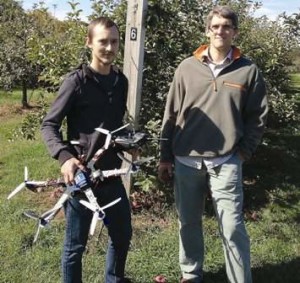A University of New Hampshire plant pathologist and his doctoral student are using a remote-controlled helicopter to help apple farmers in the Northeast battle the persistent scourge of apple scab.
Kirk Broders, assistant professor of plant pathology, and Ph.D. student Matt Wallhead are working to bring precision agriculture to orchard management in the Northeast by developing a low-cost unmanned aircraft system. With a camera loaded with GPS and infrared technology, the UAS can “see” pests, nutrient stress, or early infections caused by the apple scab fungus.
“You and I can only see a small percentage of the light spectrum,” Broders said. “We see chlorophyll as green, but it can also be seen as red at different wavelengths.”
The multi-spectrum images produced by the camera on their UAS shows chlorophyll in variations of red, the interpretation of which can lead to a clearer understanding of what problems, like apple scab, may be present in the crop and enable farmers to take targeted intervention.
Apple scab, persistent in the damp Northeast, is a major concern among farmers and orchard managers. It causes dark “scabs” on the leaves and the skin of apples; while they’re harmless and have no effect on the flavor, the blemishes render the apples unmarketable. A farmer can easily spend a full day scouting an orchard for pests, fungi and nutrient stress on foot, a task that goes from time-consuming to impossible on larger orchards.
The researchers’ UAS could do daily surveillance of an entire orchard, helping farmers pinpoint problems and target the use of fungicides and protectants for maximum impact and minimal environmental damage.
Broders and Wallhead are collaborating with Massachusetts-based Rotary Robotics to build the craft, which has six propellers for precision lift, hover and zoom, at a price point of $2,500.
“We aim to create a UAS that an independent researcher or grower could afford,” said Broders, who also envisions multiple farmers having joint ownership of a single machine.
Currently fine-tuning their prototype and mastering flying it over orchards at UNH’s Woodman and Kingman farms, they estimate their product is five years away from the marketplace. Broders and Wallhead are one of the first research groups to work on such a project with apples, although drones have been increasingly used for non-military purposes, such as monitoring vineyards in France and tracking endangered animals, in recent years.
The researchers expect their UAS — designed for the regular surveying of smaller orchard production-scale systems as well as for large row crops like corn, soybean, rice, and wheat — will detect disease outbreaks, determine fertility requirements and assess overall crop health and yield potential, Broders said.
The New Hampshire Agricultural Experiment Station of the College of Life Sciences and Agriculture at UNH funded this project.
Photo: University of New Hampshire doctoral student Matt Wallhead (left) and assistant professor of plant pathology Kirk Broders – Rachel Rohr
Source: Seacoastline

